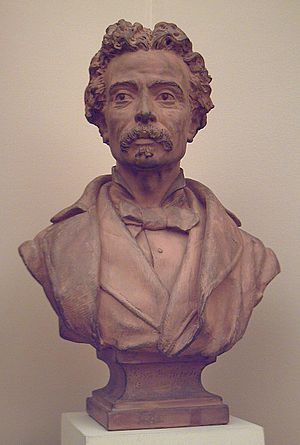Jesús de Monasterio facts for kids
Jesús de Monasterio y Agüeros (born March 21, 1836 – died September 28, 1903) was a talented Spanish violin player, composer, conductor, and teacher. He was very important in helping instrumental music grow in Madrid during the 1800s.

Contents
Early Life and Learning
Jesús de Monasterio was born in Potes, a town in Cantabria, Spain. He started learning the violin from his father, who played the instrument as a hobby. Later, he continued his lessons in Valladolid with a teacher named José Ortega Zapata.
His first public performance was in 1843 when he was just seven years old. People were amazed by how well he played the violin at such a young age. One magazine, La Iberia Musical y Literaria, wrote that he caused "inexplicable admiration" and was "crowned and named partner of merit." They called him a "little angel" and a "phenomenon" because of his incredible talent.
After this, Jesús moved to Madrid to continue his studies. He even played a concert for the Infanta Isabel de Borbón, a Spanish princess. Because of his talent, he received money to help with his studies and even a new violin. Many newspapers and music magazines wrote about him during these early years, and he became an honored member of several music groups.
In 1845, after his father passed away, Jesús got the chance to study with a famous violinist named Charles Auguste de Bériot at the Royal Conservatory of Brussels in Belgium. While there, he also learned about harmony with Lemmens and counterpoint (a way of writing music) with Fétis. In 1852, he won a special award called the Prix extraordinaire from the Conservatory, which had been delayed because he was so young.
European Concert Tours
After finishing his studies in Brussels with great success, Jesús de Monasterio returned to Madrid. He was named an honorary violinist for the Capilla Real de Madrid, which was the royal chapel's music group.
He then began a career as a virtuoso, which means a musician with amazing technical skill. He was invited to play at music festivals in England and Scotland. He performed with other important musicians of his time, like Marie Pleyel and Heinrich Ernst. People in London especially admired him, comparing him to the best violinists of his generation.
He also played concerts in Belgium, the Netherlands, and Germany. In Germany, he performed his own violin concerto (a long piece for violin and orchestra) in a concert with the famous composer Giacomo Meyerbeer. During these tours, he often played his own compositions, such as the Fantasía Característica Española and Adiós a la Alhambra.
Teacher and Music Leader in Madrid
In 1857, Monasterio became a professor at the Madrid Conservatory, a major music school. He also continued his work at the Capilla Real de Madrid. Later, in 1894, he became the director of the Conservatory.
When his former teacher, Charles Auguste de Bériot, died in 1870, Monasterio was offered a teaching job at the Brussels Conservatoire. However, he chose to stay in Spain.
Jesús de Monasterio was very concerned about the state of chamber music (music for a small group of instruments) in Spain. To help improve it, he teamed up with the pianist Juan María Guelbenzu to create the Sociedad de Cuartetos de Madrid (Quartet Society of Madrid) in 1863. This society held regular chamber music concerts for many years, until 1894.
In 1864, he started conducting orchestras. By 1869, he became the conductor of the Sociedad de Conciertos de Madrid (Concert Society of Madrid). As a conductor, he introduced Spanish audiences to orchestral works by great Romantic and neo-classical composers, whose music was not well-known in Spain at the time. He also helped the orchestra improve its technical and artistic skills. The Concert Society performed both classic pieces and new works by Spanish composers.
Jesús de Monasterio passed away in Casar de Periedo at the age of 67.
Musical Works
Jesús de Monasterio wrote many different kinds of musical pieces.
Instrumental Music
He composed music for the violin and piano, including:
- Nocturno (a calm, dreamy piece)
- Adiós a la Alhambra (meaning "Goodbye to the Alhambra")
- Grande fantasie nationale sur des airs populaires espagnoles (a big fantasy based on Spanish folk tunes)
- Pequeña fantasía de salón (a small fantasy for a parlor)
- Sierra Morena (named after a mountain range in Spain)
He also wrote pieces for violin and orchestra, such as:
- Fantasía original española (Original Spanish Fantasy)
- A Violin Concerto
For those learning music, he created:
- Veinte estudios artísticos de concierto (Twenty Artistic Concert Studies), which are pieces designed to help musicians practice and improve their skills.
His orchestral works included:
- Marcha fúnebre y triumfal (Funeral and Triumphal March)
- Scherzo fantástico (Fantastic Scherzo)
- Andante religioso (Religious Andante)
He also wrote some pieces for solo piano, like La violeta and Tristeza.
Vocal Music
Jesús de Monasterio composed songs for voice and piano, such as:
- La violette et le camélia
- Las dos hermanas (The Two Sisters)
- Acuérdate de Mí (Remember Me)
- El cautivo (The Captive)
He also wrote non-religious vocal pieces like Le retour des matelots (The Return of the Sailors) and El regreso a la patria (The Return to the Homeland).
Additionally, he composed many religious works, including:
- Ave verum corpus (a motet, or short religious choral piece)
- Several Salve pieces (hymns to the Virgin Mary)
- Plegaria a la Santísima Cruz (Prayer to the Holy Cross)
- Requiescat in pace (Rest in Peace)
- O sacrum Convivium (O Sacred Banquet)
See also
 In Spanish: Jesús de Monasterio para niños
In Spanish: Jesús de Monasterio para niños

